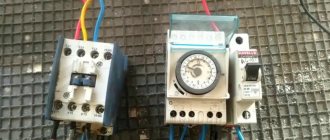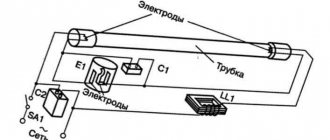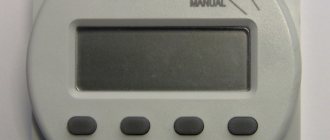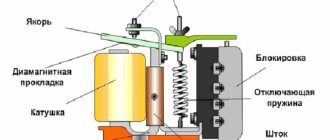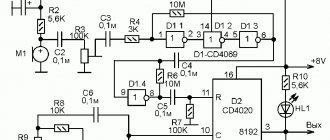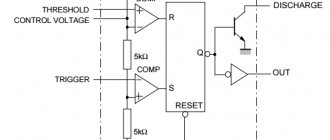About new developments
During the operation of the TE-15 device, a number of shortcomings were revealed, one of which, as noted, was a temporary malfunction of the LCD display.
Therefore, in order to increase operational reliability and improve the existing device, EKF began to supply models of new digital timers such as TE-80 and TE-80-24-230. These models, like the TE-15, belong to the PROxima line, but they have improved characteristics.
In later models, the number of programs available to the user has increased significantly. For example, they already remember up to 40 on/off cycles.
The introduced additional pulse operating mode allows you to double the number of operating cycles. In addition, for example, the cost of the TE-80 device model does not differ from the cost of the TE-15.
Thanks to the increased display size and more convenient buttons, it has become much easier to program and operate the device. Additionally, the electronic timer TE-80-24-230 has the ability to operate from a 24 V DC source.
Also, offline storage of information is provided in TE-80 for up to three years, and in TE-80-24-230 for up to 10 years.
Conclusion
Thus, in recent years, the time relay fleet has undergone significant changes. Electronic digital timers have replaced outdated electromechanical devices.
Devices built on the basis of microprocessor technology have a number of advantages and wide possibilities for connection and operation.
Flexible configuration, simple programming, small size and ease of load switching allow the use of electronic timers to control various types of technological equipment. They have become an integral part in both industry and the domestic sector.
PPS The main tool for making money online and not only is a computer. How to give it reliability, making it fast and immortal, and also speed up its operation up to 30 times is given in the following newsletter: barabyn.ru/wp/computer.
About new developments
During the operation of the TE-15 device, a number of shortcomings were revealed, one of which, as noted, was a temporary malfunction of the LCD display.
Therefore, in order to increase operational reliability and improve the existing device, EKF began to supply models of new digital timers such as TE-80 and TE-80-24-230. These models, like the TE-15, belong to the PROxima line, but they have improved characteristics.
In later models, the number of programs available to the user has increased significantly. For example, they already remember up to 40 on/off cycles.
The introduced additional pulse operating mode allows you to double the number of operating cycles. In addition, for example, the cost of the TE-80 device model does not differ from the cost of the TE-15.
Thanks to the increased display size and more convenient buttons, it has become much easier to program and operate the device. Additionally, the electronic timer TE-80-24-230 has the ability to operate from a 24 V DC source.
Also, offline storage of information is provided in TE-80 for up to three years, and in TE-80-24-230 for up to 10 years.
Conclusion
Thus, in recent years, the time relay fleet has undergone significant changes. Electronic digital timers have replaced outdated electromechanical devices.
Devices built on the basis of microprocessor technology have a number of advantages and wide possibilities for connection and operation.
Flexible configuration, simple programming, small size and ease of load switching allow the use of electronic timers to control various types of technological equipment. They have become an integral part in both industry and the domestic sector.
Source
Time relay
A time relay is a simple modern automatic device. Everything here is clear on an intuitive level and such devices are very widely used in a variety of schemes for automating technological operations.
Nowadays, time relay tasks can be performed by programmable logic controllers, however, the “old” devices have not yet been completely replaced.
The purpose of the time relay is to switch electrical circuits with a preset time delay.
Modern time relays are time controllers that can be programmed to solve specific problems.
These devices are capable of providing the required time interval, taking into account a certain algorithm for connecting elements in an electrical circuit. Most often they are used when it is necessary to automatically start devices after a certain time interval after the main signal has been received.
A variety of time relay designs determine the use of the device at the domestic and industrial level.
About new developments
During the operation of the TE-15 device, a number of shortcomings were revealed, one of which, as noted, was a temporary malfunction of the LCD display.
Therefore, in order to increase operational reliability and improve the existing device, EKF began to supply models of new digital timers such as TE-80 and TE-80-24-230. These models, like the TE-15, belong to the PROxima line, but they have improved characteristics.
In later models, the number of programs available to the user has increased significantly. For example, they already remember up to 40 on/off cycles.
The introduced additional pulse operating mode allows you to double the number of operating cycles. In addition, for example, the cost of the TE-80 device model does not differ from the cost of the TE-15.
Thanks to the increased display size and more convenient buttons, it has become much easier to program and operate the device. Additionally, the electronic timer TE-80-24-230 has the ability to operate from a 24 V DC source.
Also, offline storage of information is provided in TE-80 for up to three years, and in TE-80-24-230 for up to 10 years.
Conclusion
Thus, in recent years, the time relay fleet has undergone significant changes. Electronic digital timers have replaced outdated electromechanical devices.
Devices built on the basis of microprocessor technology have a number of advantages and wide possibilities for connection and operation.
Flexible configuration, simple programming, small size and ease of load switching allow the use of electronic timers to control various types of technological equipment. They have become an integral part in both industry and the domestic sector.
Source
The operating principle determines five main types of relays:
- Electromagnetic retardation . Such a device can only be used in DC circuits. The time delay occurs due to the additional winding, which prevents the increase in magnetic flux.
- Pneumatic retardation . A pneumatic damper is used here, which changes the air intake opening.
- Anchor or clock mechanism . Here the electromagnet charges a special spring, which closes the relay after counting down the set time.
- Using the engine . It uses a synchronous electric gearbox, a motor and an electromagnet. The first two elements are coupled by an electromagnet.
- Electronic relay . Microcontrollers are used here to program turn-on delays.
Electronic astronomical timer TE-AS
Purpose
To turn on/off the load at a programmed time with operating modes on a daily cycle with the ability to automatically adjust the set time depending on the time of sunrise and sunset at different times of the year.
Application
- In industrial and household electrical installations for automation of lighting control.
- Control of street lighting, illumination of facades, parking lots, shop windows, parks, bus stops, etc.
- Controlling the lighting of advertising structures
- Interior lighting control: illumination of shop windows, lighting of entrances, office centers, hotel corridors, industrial areas, warehouses, etc.
Design and operating principle
- The timer works in relation to the geographic latitude of the installation location and the time of year. The set time will be automatically adjusted every day depending on the time of sunrise and sunset (Figure 1);
- It is possible to program the lighting to turn on and off at any time, for example, turn it on 20 minutes after sunset and turn it off 20 minutes before sunrise, which will further save energy (Scheme 2);
- Additional energy saving is provided by the function of programming a break in work at night (for example, from 1 am to 5 am (diagram 3)).
Timer programming is carried out in three stages:
- setting the current date and time
- setting the geographic latitude of the timer installation location (see table at the end of the section)
- setting the required on and off times.
Source
Design
TE15 timers consist of the following components: power supply, microprocessor, LCD display, programming buttons, relays with switching contacts, contact clamps, backup battery and light indicator for relay activation.
Timers operate based on the current time and day of the week.
Timer microprocessors provide 8 cycles of control over the time the load is turned on and off. Programming is carried out using buttons located on the front panels of the timers.
Setup and programming
In the operating instructions, the operating modes are displayed in the following table:
Features of the device and detailed instructions for programming it are also set out in the manual. Therefore, it only makes sense to visually explain some actions.
1. Press the round button below the “RESET” inscription.
2. For about 8 s, the status of the device’s components is polled, all valid characters are displayed on the display and a countdown starts.
- 3. Set the 12-hour or 24-hour operating mode by pressing the “Clock” button and holding it for about 5 seconds. The display will show “AM” or “PM”, meaning half day or full day.
4. While holding the “Clock” button, set the current date and time by pressing the buttons. “D+”, “Ch+” and “M+”. After releasing the “Clock” button, use the “D+” button to select the current day of the week. The display shows “MO”, “TU”, “WE”, “TN”, “FR”, “SA”, “SU”.
5. Set the first cycle of turning on the device by first pressing the “P” button, set the date and time as in the previous paragraph.
- 6. To memorize the set values, press the “P” button again.
- 7. Programming of other on/off cycles is carried out in the same way. There are a total of 16 programming cycles.
- 8. Use the “MODE” key to select one of 4 modes of turning on or off the load.
Switch-on and switch-off settings
- Resetting programs and time
- Setting the current time and day of the week
- Cycle programming
- Making changes to a programmed cycle
After pressing the “RESET” button, the programmed cycles will be deleted, if any; in this case, all the symbols of the LCD display will be displayed, then the clock will be reset to zero (00:00), the “Auto off” mode and the day of the week “SU” (Sunday) will be displayed - which will indicate the success of this operation.
1).
It is necessary to set
the time display mode
- 24 / 12 hour with the mark “AM” (before noon) / “PM” (after noon).
To select, press and hold the button with the clock image for 3 seconds. 2).
By holding down the "CLOCK" button, we switch between days of the week (Mon - Sun) in a circular manner by pressing the "D+" button. Having stopped on the desired day of the week, without releasing the first dial button, press “Х+” until the current hour is displayed. By analogy with days and hours, we set the minutes.
After pressing the “P” button, the possibility of programming half of the cycle responsible for turning on (1 ON) is indicated. By pressing “D+” we select one of 9 triggering variations - on weekdays, all days, the first 3 days of the week, only Sat + Sun, etc.; then use the “H+” and “M+” buttons to set the time in a ring pattern and press “P” again - the shutdown cycle “1 OFF” will be displayed (hereinafter, by analogy with “1 ON”). To save the final cycle (which can be pressed the “CLOCK” button.
By pressing “D+” we select one of 9 triggering variations - on weekdays, all days, the first 3 days of the week, only Sat + Sun, etc.; then use the “H+” and “M+” buttons to set the time in a ring pattern and press “P” again - the shutdown cycle “1 OFF” will be displayed (hereinafter, by analogy with “1 ON”). To save the final cycle (which can be pressed the “CLOCK” button.
By pressing the "CLOCK" button several times and waiting for the number of the required cycle (switching in a circle) - then the "MODE" button - a reset will occur with the possibility of reprogramming ( - : -), then using "D +", "H +", "M" +" make the necessary changes.
The cost of installing and setting up the timer depends on the number of on/off settings - Go to the page with detailed prices for services
Electronic timer TE 15. Design, configuration and application.
In everyday life we use many electrical mechanisms, the regularity of which suggests the idea of automating the process. For example, controlling outdoor lighting or a well pump. This idea is not new, and there are a lot of devices for this purpose, which are collectively called time relays (electronic timers).
Programmable weekly electronic timer TE 15 (Fig. 1) is a device that can control many household devices. He is a shining example of the benefits of modern technology. To verify this, it is enough to remember what devices you had to use before.
Electronic timer TE-15. Setup, connection and operation features
Greetings, dear reader! Thank you for showing interest in my diary...
Special devices that count the time intervals between events are called timers. After a specified period of time has elapsed, a special signal is removed from such a device or it turns the equipment on/off.
Devices built on radio-electronic elements and triggered depending on the current time of day are called real-time electronic timers. The basis of the design of such devices is usually a clock mechanism. The alarm clock we are used to is an analogue of the simplest such device.
Currently, digital timers are widely used in various industries, as well as in the household sector. They allow, for example, turning electrical equipment on and off, thereby saving energy.
They can be programmed for either a day or a week. Their setup, connection and operation features are not particularly difficult. One of such devices is the TE-15 electronic timer.
Electronic timer
Equipment > Modular devices
Electronic timers (TE-02, TE-15, TE-16) are used in household and industrial electrical installations to automatically turn on/off power to various electrical equipment at a user-specified time and to count time intervals.
See also on Websor
Automatic switches Design, type, operation characteristics of automatic switches. Selection of circuit breakers. Characteristics automatic. off Residual current devices (RCDs) Operating principle, classification and types of RCDs. Selection and application of RCDs Reasons for tripping of RCDs Differential automatic. off Load switches Modular contactors Characteristics KM. Schemes of application in lighting control and electric motors. Surge limiter. Characteristics of SPD. Scope of application. Sources of surge voltages. Classification of electrical equipment according to resistance to overvoltage. Additional devices Status contacts, releases, modular control buttons.
Easy to operate and install. A single-phase load greater than or equal to the switched current is connected through a contactor (electromagnetic starter); three-phase load - only through a contactor. Installation of TE-02 and TE-15 is carried out on a DIN rail; TE-16 onto the mounting plane through technological holes in the housing.
Source
Download instructions (passport) for time relay
Step-by-step instructions for setting up and programming an electronic weekly time relay can be downloaded or printed for free here; a passport description and purpose of the time relay control buttons; programming and setting algorithm
time relay, timer for turning on and off the light by time, what is a time relay, time relay, electronic timer instructions, turning on the light by time, timer to turn off the light, this is a time relay, time relay connection, buy a time relay, electronic timer, TE 15 , time relay circuit, time relay 220 Volt, programmable time relay, gravity watering timer, shutdown timer, relay, electronic programmable timer, with non-volatile memory, switching current 16 amperes, full time range from 1 minute to 168 hours, 16 programs, THC 15A, download the passport of the time relay in Russian, download the instructions for the time relay in Russian, time relay on one relay, what is a time relay, what is a time relay, timer for turning on and off 220V, lighting control for the courtyard of a private house, electronic relay time iek instruction 220v programmable
Technical characteristics of the TE15 timer
| Parameter | Meaning |
| Rated operating voltage, V | 230 |
| Operating voltage range, V | 180…264 |
| Rated frequency of the supply network, Hz | 50 |
| Number of on/off programs | 8 |
| Minimum interval for setting the program operating time, min | 1 |
| Switching capacity | 16 A/250 V AC at cos j = 1; 8 A/250 V AC at cos j = 0.5 |
| Backup power supply | Battery |
| Accuracy | ± 2 seconds per day at +20°C |
| Degree of protection | IP 20 |
| Power reserve | 150 hours |
| Mechanical wear resistance, VO cycles, not less | 107 |
| Electrical wear resistance, VO cycles, not less | 105 |
| Power consumption, no more, W | 5 |
| Installation method | mounting with fixation on 35 mm DIN rail |
| Overall dimensions, mm | 82x36x66 |
| Weight, kg | 0.150 |
Advantages
- The timers are equipped with a backup rechargeable power source, ensuring their operation for 150 hours when the mains power is turned off;
- The variety of available operating modes (all days of the week, a specific day, weekdays, weekends, etc. - 15 modes in total) allows you to program the timer to suit any needs of the technological process of varying levels of complexity;
What does programming a socket include?
It is worth dwelling in more detail on the method of programming an outlet with a timer:
- First you need to set the exact time. To do this, click on Clock with a sharp object, then set the current day of the week (Week key), hour (Hour) and minutes (Min).
- We designate the turn-on time - you will need a Timer button. After pressing this button, the display will show On 1. Next, you can set the timer to turn off. The time can also be set using the Week, Hour and Min keys.
- To see if the tasks have successfully registered, you need to hold down the Timer button for a couple of seconds.
- Having finished programming, you must press the Clock key again, thereby putting the device into operating mode.
It is worth noting that the programmable socket (instructions for any model are included) can carry out scheduled tasks only in Auto mode. If the Manual on function is activated on the device, the device will act as a simple socket, and the Manual off function completely turns off the device.
Design features of the TE-15 device
Today our existence is not complete without the use of many electrical appliances. Regular use, for example, of outdoor lighting, aquarium lighting, electric pump, heating boiler and other equipment, prompts the idea of automating the process of turning them on and off. For this purpose, there are a lot of different devices, among which a special place is given to the time relay.
The TE-15 device is a weekly electronic programmable timer. It is manufactured in China and adapted for Russian-speaking users. It is an analogue of the SASSIN 3SHC18A device. The appearance of the TE-15 device is shown below.
Device composition
The mounting device allows you to mount the time relay on a standard 35 mm DIN rail, which should preferably be installed in a distribution board with a degree of protection of at least IP 20.
The structural elements of the timer are placed in a plastic case, on the front panel of which there are controls in the form of buttons with rubber caps. The electrical network is connected to the upper terminals, and the load is connected to the lower ones.
The device includes the following components:
- microprocessor with control circuits;
- liquid crystal (LCD) information display;
- device programming block;
- executive load relay with powerful contacts;
- miniature switching power supply;
- built-in battery.
Using a microprocessor, software controls the load taking into account the current time of day. The liquid crystal display displays the current time, and is also used to select, configure and set operating modes of the device.
The LED indicator notifies you when the equipment is turned on or off.
Liquid crystal display
The perception of data displayed on the liquid crystal display is much more convenient, which is a plus of this device. The LCD display board and its connections are shown below. In updated models of the device, the LCD display shows additional seconds.
Switching relay
The electronic timer uses a relay manufactured by OMRON. It has the AC1 characteristic, that is, the power relay contacts allow you to switch an active or low-inductive type of load, the current consumption of which is not higher than 16 A.
Timer output part
An additional layer of solder is applied to the current-carrying tracks of the output circuits used to connect the load. The contacts of the switching relay are capable of withstanding current up to 16 A. However, despite this, the output part of the device does not have protection from both overloads and short circuits.
In order to prevent an emergency and ensure proper operation, you should additionally use a circuit breaker with a rated current of no higher than 16 A with the device.
Electrical equipment that consumes high current and also represents an inductive load is recommended to be connected using a contactor of the required power.
Built-in battery
In cases of power outages or interruptions, the set values are maintained thanks to a backup power source. A non-Cell-manganese replaceable battery is used as such.
Battery voltage - 1.2 V, capacity - 40 mAh, service life - 3-5 years. The digital timer can operate for about 150 hours on battery power.
setting the TE-15 timer.
| Weekly electronic timer TE-15. Setup and connection diagram |
| You can buy a similar timer here: This video is an addition to the article about the weekly... |
| Tags: |
| EKF Electronic timer TE-15 |
| Find out the operating principle of the electronic timer TE-15 with EKF. |
| Tags: |
| Time relay T15 Elektro setting |
| electric timer for birds, installation, how to connect, auto light in the chicken coop, automatic door, auto... |
| Tags: |
| timer |
| The timer can turn on or off any device with a current consumption of up to 16 amperes. Programming... |
| Tags: |
| Electronic timer |
| You can order on Aliexpress using the link Setting up a weekly timer on a din rail Your reliable… |
| Tags: |
| Weekly timer on Din rail. Setup instructions |
| Brief overview of Timer TE-15 EKF. |
| Tags: |
| Electronic timer TE-15 |
| Connecting and setting up the TM41 timer. You can buy it in the online store... |
| Tags: |
| Electronic timer Feron TM41 on DIN rail |
| So that the light turns on/off according to time. We put into operation an electronic timer for connecting electrical... |
| Tags: |
| Light by time. Tricks for connecting and setting a timer on a DIN rail |
| Timer TE-02, or any other, is connected in the same way. |
| Tags: |
| timer connection diagram |
| comments y zhazayyk dostar. |
| Tags: |
| Electronic timer. Electronic street lighting timer |
| Brief overview and application of the Data Log (Orbis) digital timer. ——————— Similar videos on the channel: 1. Weekly… |
| Tags: |
| Electronic timer Data Log (Orbis) |
| Link: (was for $10) Tools and materials: HoldPeak HP890CN Silicone... |
| Tags: |
| A well-thought-out time relay (timer) in a DIN rail. |
| EPN cash back service for purchases in China Speaker Zealot S9 ... |
| Tags: |
| Electronic timer relay sq1506 0002 setting |
| Designed for automatic switching on/off of a household electrical appliance with power... |
| Tags: |
| Unpacking, test, review and setup Time relay from China (DIGITAL PROGRAMMABLE TIMER) |
| On aliexpress with - Similar videos. FM modulation, FM transmission to 3.5mm jack. China. Package … |
| Tags: |
| Automatic timer t-15 IEK |
| Review and setup of a weekly modular timer on a Din rail from the French brand Hager, model EG 071. |
| Tags: |
| time relay |
| Description missing |
| Tags: |
| Electronic timer with weekly programming |
| Description missing |
| Tags: |
| Timer. Setup. China. Analogue EKF, IEK |
| Description missing |
| Tags: |
| Weekly timer Hager EG 071 (review and setup) |
Electronic timer TDM Electric SQ1503-0023 TE-AS 16A DIN astronomical
Description
To turn on/off the load at a programmed time with operating modes on a daily cycle with the ability to automatically adjust the set time depending on the time of sunrise and sunset at different times of the year.
Application
- In industrial and household electrical installations for automation of lighting control.
- Control of street lighting, illumination of facades, parking lots, shop windows, parks, bus stops, etc.
- Controlling the lighting of advertising structures
- Interior lighting control: illumination of shop windows, lighting of entrances, office centers, hotel corridors, industrial areas, warehouses, etc.
Materials
device body made of flame retardant plastic
Design and operating principle
- The timer works in relation to the geographic latitude of the installation location and the time of year. The set time will be automatically adjusted every day depending on the sunrise and sunset times;
- It is possible to program the lighting to turn on and off at any time, for example, turn it on 20 minutes after sunset and turn it off 20 minutes before sunrise, which will further save energy;
- Additional energy saving is provided by the function of programming a break in work at night (for example, from 1 am to 5 am).
- Programming the timer is carried out in three stages: setting the current date and time
- setting the geographic latitude of the timer installation location
- setting the required on and off times.
Advantages
- Lighting control is fully automated, because The timer itself adjusts the on and off times depending on the time of year.
- Equipped with a backup rechargeable power supply that ensures operation for 360 hours when the power supply is turned off.
- The most affordable offer of timers of this type on the market of the Russian Federation and CIS countries
Characteristics
- Rated load current In: at cos φ=1 - 16 A, at cos φ=0.4 - 8 A
- Rated voltage: 230V
- Operating voltage range: 180-250 V
- Rated frequency: 50Hz
- Power consumption: no more than 5 W
- Number of memory cells: ON+OFF 8+8
- Time delay setting step: 1 min
- Geographic latitude setting range: 0 to 66 degrees
- Time interval report error: 2 s/day
- Operating time from backup power source during network outage: 360 hours
- Electrical wear resistance: no less than 100,000 electrical cycles
- Mechanical wear resistance: no less than 10,000,000 cycles
- Power consumption: 4 VA
- Contact type: 1P (changeover)
- Weight: 0.125 kg
- Installation method: DIN rail
- DIN rail timer width: 36 (2 DIN modules)
- Operating temperature range: -10…+40 0С
Technical information
| Brand |
Timer connection options
The connection diagram for the electronic model timer can be made in two main versions. It is most convenient to consider these schemes using the example of the domestic IEK timer, which is widespread in various fields. This model runs on microprocessors, has a liquid crystal display and can be programmed using buttons. The rated load current for this device is 16 amperes, which allows it to freely drive most household loads.
The specified switching is carried out using relays and contacts Nos. 3, 4, 5. The voltage to power the timer is supplied through separate terminals Nos. 1 and 2. Switching contacts allow you to perform operations with loads not only with simple actions, but also to simultaneously close or open another electrical circuit.
Design features of the TE-15 device
Today our existence is not complete without the use of many electrical appliances. Regular use, for example, of outdoor lighting, aquarium lighting, electric pump, heating boiler and other equipment, prompts the idea of automating the process of turning them on and off. For this purpose, there are a lot of different devices, among which a special place is given to the time relay.
The TE-15 device is a weekly electronic programmable timer. It is manufactured in China and adapted for Russian-speaking users. It is an analogue of the SASSIN 3SHC18A device. The appearance of the TE-15 device is shown below.
Device composition
The mounting device allows you to mount the time relay on a standard 35 mm DIN rail, which should preferably be installed in a distribution board with a degree of protection of at least IP 20.
The structural elements of the timer are placed in a plastic case, on the front panel of which there are controls in the form of buttons with rubber caps. The electrical network is connected to the upper terminals, and the load is connected to the lower ones.
The device includes the following components:
- microprocessor with control circuits;
- liquid crystal (LCD) information display;
- device programming block;
- executive load relay with powerful contacts;
- miniature switching power supply;
- built-in battery.
Using a microprocessor, software controls the load taking into account the current time of day. The liquid crystal display displays the current time, and is also used to select, configure and set operating modes of the device.
The LED indicator notifies you when the equipment is turned on or off.
Liquid crystal display
The perception of data displayed on the liquid crystal display is much more convenient, which is a plus of this device. The LCD display board and its connections are shown below. In updated models of the device, the LCD display shows additional seconds.
Switching relay
The electronic timer uses a relay manufactured by OMRON. It has the AC1 characteristic, that is, the power relay contacts allow you to switch an active or low-inductive type of load, the current consumption of which is not higher than 16 A.
Timer output part
An additional layer of solder is applied to the current-carrying tracks of the output circuits used to connect the load. The contacts of the switching relay are capable of withstanding current up to 16 A. However, despite this, the output part of the device does not have protection from both overloads and short circuits.
In order to prevent an emergency and ensure proper operation, you should additionally use a circuit breaker with a rated current of no higher than 16 A with the device.
Electrical equipment that consumes high current and also represents an inductive load is recommended to be connected using a contactor of the required power.
Built-in battery
In cases of power outages or interruptions, the set values are maintained thanks to a backup power source. A non-Cell-manganese replaceable battery is used as such.
Battery voltage - 1.2 V, capacity - 40 mAh, service life - 3-5 years. The digital timer can operate for about 150 hours on battery power.
A little history
Previously, a mechanical timer was popular. Built into an outlet, it could turn on household appliances for a certain time (see Fig. 2). In essence, it was a countdown timer; accordingly, its scope of application was limited.
Rice. 2 Kitchen timer - Lemanso LM671 socket
In fact, this is an ordinary socket with a timer; the peak of popularity of such devices occurred in the mid-80s of the last century. Time passed, gradually mechanical devices replaced electromechanical ones, which, in turn, were replaced by electronic ones, such as an electronic stopwatch. The functionality of these devices has expanded significantly. Now it's the turn of digital devices.
Let's return to the topic of the article.
Setup and programming
In the operating instructions, the operating modes are displayed in the following table:
Features of the device and detailed instructions for programming it are also set out in the manual. Therefore, it only makes sense to visually explain some actions.
1. Press the round button below the “RESET” inscription.
2. For about 8 s, the status of the device’s components is polled, all valid characters are displayed on the display and a countdown starts.
- 3. Set the 12-hour or 24-hour operating mode by pressing the “Clock” button and holding it for about 5 seconds. The display will show “AM” or “PM”, meaning half day or full day.
4. While holding the “Clock” button, set the current date and time by pressing the buttons. “D+”, “Ch+” and “M+”. After releasing the “Clock” button, use the “D+” button to select the current day of the week. The display shows “MO”, “TU”, “WE”, “TN”, “FR”, “SA”, “SU”.
5. Set the first cycle of turning on the device by first pressing the “P” button, set the date and time as in the previous paragraph.
- 6. To memorize the set values, press the “P” button again.
- 7. Programming of other on/off cycles is carried out in the same way. There are a total of 16 programming cycles.
- 8. Use the “MODE” key to select one of 4 modes of turning on or off the load.
Weekly 1-channel timer TE-15 is designed for counting time intervals, automatically turning on/off electrical equipment after a specified period of time during the week and controlling various devices. The relay has 1 changeover contact .
Operating conditions for timer TE-15:
— Operating temperatures from -10 to +40°С at a relative humidity of 98%.
— The height above sea level is no more than 2 thousand meters.
— The environment is explosion-proof and does not contain dust in quantities that would interfere with the operation of the timer, as well as aggressive gases and vapors in concentrations that destroy metals and insulation.
Technical characteristics of time relay TE15:
| Basic operating voltage, V | 230 |
| Operating voltage range, V | from 180 to 264 |
| Base frequency of the supply network, Hz | 50 |
| Number of programs on/off | 8 |
| Minimum interval for setting the program operating time, min | 1 |
| Switching capacity | 16 A/250 V AC at cosj= 1 |
| 8 A/250 V AC at cosj= 0.5 | |
| Backup power supply | battery |
| Accuracy | ±2 seconds per day at +20°С |
| Protective degree | IP 20 |
| Power reserve | 150 hours |
| Mechanical wear resistance, VO cycles, not less | 10^7 |
| Electrical wear resistance, VO cycles, not less | 10^5 |
| Power consumption, no more, W | 5 |
| Installation method | mounting with fixation on 35 mm DIN rail |
| Overall dimensions, mm | 82x36x66 |
| Weight, kg | 0.150 |
Design and operation of TE15:
The timer consists of the following components: power supply, microprocessor, liquid crystal display, programming buttons, relay with switching contacts, terminal block, backup battery and LED indicator for relay activation. The timer microprocessor ensures the execution of 8 cycles of programs for controlling the time of turning on and off the load. The timer is programmed using buttons located on the front panel. The liquid crystal display of the timer has two indication modes: current time (switched on by the clock button) and programming (switched on by the button "). The “ON” indicator on the front panel turns on when the relay is activated. The supply voltage is supplied to terminals 1 and 2. The load is connected to terminals 4 (common), 5 (NO contact), 3 (NC contact).
Programming and setting up the TE-15 relay:
Connect the timer to a power source. Click the RESET button. During the first 8 seconds, the timer status is polled (all the symbols on it are displayed on the liquid crystal display), then the time countdown starts. The initial state of timekeeping is on a 24-hour scale. To switch to the 12-hour scale, keep the "" button pressed for 5 seconds (the display will show "AM" or "PM", to return to the 24-hour scale, keep the "" button pressed for 5 seconds. Set the current date and time. To do this with the “” button pressed: using the “D+” (day) button, set the current day of the week (MO - Monday, TU - Tuesday, WE - Wednesday, TH - Thursday, FR - Friday, SA - Saturday, SU - Sunday ); using the “H+” (hours) button, set the current time in hours; using the “M+” (minutes) button, set the current time in minutes.
Set the timer program according to the table.
| Step | Press the button | Function performed | Indication |
| 1 | Setting the 1st switching cycle | "1" "ON" | |
| 2* | "D+" | Setting the days of the week | Symbols of the days of the week |
| 3 | "Ch+" / "M+" | Installation | Time in numbers |
| 4 | Setting the 1st switching cycle | "1" "OFF" | |
| 5 | "D+" | Installation | Symbols for the days of the week |
| 6 | "Ch+" / "M+" | Installation | Time in numbers |
| 7 | Repeat steps 2...6 | Installation | Matches pitch |
| 8* | Programming is complete | Current time in numbers |
* 10 options are possible: any day of the week, seven days of the week, five working days of the week from Monday to Friday, weekends Saturday and Sunday. ** By pressing the "" button you can complete any number of cycles.
If it is necessary to cancel a previously programmed on or off cycle, you must press the “” button to select this cycle and press the “MODE” button. In this case, the time will be shown as dashes on the indicator. You can re-enable the installed program by pressing the “MODE” button. In this case, the indicator will display the time it takes to complete this operation. Re-enabling the installed timer operating program can be done with the “MODE” button: - in the initial (off) state of the relay contacts (indication of the inscription “AUTO OFF”); - when the relay contacts are in the on (inverted) state (indication of the inscription “ON AUTO”). If necessary, you can disable the timer operating program and set the required state of the contacts manually using the “MODE” button: - initial (off) state of the relay contacts (indication of the inscription “OFF”); — on (inverse) state of the relay contacts (indication of the inscription “ON”).
Connection diagram for time relay TE-15:
Overall and installation dimensions of the TE15 timer:
You can buy a TE-15 timer of excellent quality and at a low price. We provide discounts to our regular customers! Tel.
- Back
- Forward
Manufacturer
IEK GROUP is one of the leading Russian suppliers and manufacturers of lighting and electrical equipment under the IEK brand, ONI industrial automation equipment and ITK IT technology products.
The company offers the widest range of equipment for the formation of integrated solutions in the field of construction, housing and communal services, transport, infrastructure, industry, energy and telecommunications. Possessing a modern research and production base, the company primarily invests in the development of production in Russia and strives to maximize its own production potential, contributing to the development of the electrical industry as a whole. IEK products twice, in 2014 and 2021, became the laureate of the people's trust rating of Brand No. 1 in Russia in the Electrical Engineering category. This is confirmation of successful import substitution and great consumer confidence, as well as recognition of the company as a Russian manufacturer.
Continuous launch of new products is the hallmark of IEK GROUP. Now the company has about 10 thousand items of products. IEK GROUP offers not just individual products, but comprehensive solutions with which you can organize energy supply for any facility in any industry.
The company creates products that meet all international standards. At the same time, IEK products are maximally adapted to the requirements of the domestic market and meet the expectations of Russian consumers.

